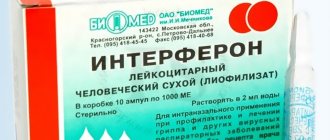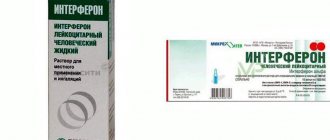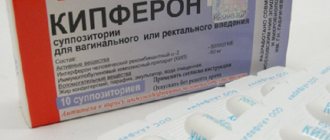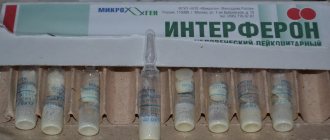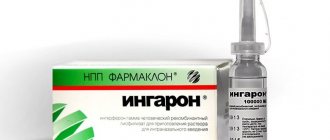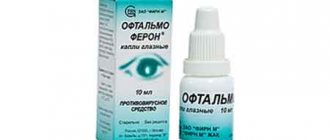Viral diseases occur to the average person several times a year. You can fight them in different ways. But the quality of treatment and the speed of recovery depends on the effectiveness of the medications used. One of the best drugs currently available for viral diseases is Interferon.
It should be noted that human leukocyte Interferon is an excellent immunomodulatory, antiviral and antitumor drug. This remedy helps the body's cells organize additional protection against the virus.
IMPORTANT: Interferons are proteins that the body produces when a virus enters it. The drug in question helps to activate the body’s process of producing protective proteins.
In 1957, virologists A. Isaac and D. Lindeman discovered an amazing protective mechanism that turns on in the body's cells at the moment of infection of one of them. This mechanism is “prescribed” at the genetic level. When one of the cells becomes infected with a virus, it produces special protein molecules (interferons). These molecules enter neighboring cells and make them immune to the virus.
Human leukocyte interferon is a protective protein that, when it enters the body, helps the immune system and fights painful viruses.
Interferon for children
- Drops of this medicine are used for the treatment and prevention of infectious viral diseases in children. This drug can be used from birth
- Prepare a solution for instillation into the nose by adding 2 ml of chilled water to an ampoule with this product. The prepared solution should be instilled into each nostril and then massaged into the wings of the nose. This is done to ensure that the solution is distributed correctly.
- To prevent ARVI, the solution for children should be instilled 5 drops into each nostril 2 times a day. At least 6 hours should pass between such instillations. For prophylaxis, this drug should be used as long as the risk of infection remains.
- If a child has signs of ARVI, you need to start taking Interferon as soon as possible. For 2-3 days you need to instill a solution of 5 drops every 1-2 hours
Indications: in what cases is the medicine used?
Who needs the drug “Human leukocyte interferon”? The drug is prescribed to people of different sexes and ages for the following pathologies:
- malignant and benign tumors in the body;
- viral diseases;
- respiratory tract infections;
- bacterial pathologies of various parts and organs;
- liver and kidney diseases (including hepatitis);
- immunodeficiency states;
- diseases of the eyes and mucous membranes;
- fungal infections;
- as a preventive measure for various diseases.
In addition, the drug “Human leukocyte interferon” is used in complex therapy. In this case, the indications may not be described in the instructions. In this case, the specialist gives recommendations individually to each patient.
Interferon dosage
- This drug in injection solution is used subcutaneously, intramuscularly and intravenously. The dosage is determined by the attending physician and depends on the age and nature of the disease.
- "Interferon" in the form of a powder or ready-made solution can be used as a liquid for inhalation
- This remedy can be used for the treatment and prevention of acute respiratory viral infections. To do this, I instill 5 drops of the solution into each nostril. For prophylaxis, 6 hours should pass between instillations. During treatment, this should be done every 1-2 hours
- For viral conjunctivitis, the solution is instilled 1-2 drops into each eye 6-8 times a day
- In the treatment of acute hepatitis B, this drug is used in the form of suppositories. The dosage should be selected by the doctor based on the individual characteristics of the body. The course of treatment should not exceed 14 days
Indications for use
Parenteral human leukocyte interferon is prescribed for:
- Hepatitis B and C;
- Multiple myeloma;
- Genital warts;
- Mycosis fungoides;
- Hairy cell leukemia;
- Non-Hodgkin's lymphomas;
- Malignant melanoma;
- Renal carcinoma;
- Kaposi's sarcoma in patients with AIDS who do not have a history of acute infections.
Rectally Interferon is used for acute and chronic viral hepatitis.
The drug is prescribed intranasally and inhaled for the prevention and treatment of acute respiratory viral infections and influenza.
Interferon in ampoules
- Ampoules with this product are the most popular form of Interferon. They are used to prevent viral diseases. To do this, the contents of the ampoule are poured into water to the 2 ml mark. Apply 5 drops of this solution to your nose twice a day.
- To treat viral diseases, you need to increase the dosage of this drug. The most intensive treatment is necessary in the first 2-3 days of the disease
- You can use Interferon for inhalation. To do this, you need to dilute the contents of the ampoule in 10 ml of warm water.
Release form and composition
Dosage forms of Interferon:
- Solution for local and inhalation use 1000 IU/1 ml (2 ml in ampoules, 5 and 10 ampoules in a cardboard box; 2 ml in bottles, 1, 5 or 10 bottles per package; in 5 ml dropper bottles , 1 per package);
- Lyophilisate for the preparation of a solution for intranasal and inhalation use 1000 IU (1 dose per ampoule, 5 or 10 ampoules per cardboard box);
- Lyophilisate for preparing a solution for intramuscular administration 10,000 IU / 1 dose (in ampoules, 5 or 10 ampoules per box complete with solvent);
- Rectal suppositories 40,000 IU (10 pieces per package).
The active ingredient of the drug is interferon alpha.
Interferon contraindications
Do not use the drug for:
- Severe heart disease
- Impaired kidney and liver function
- For chronic hepatitis and cirrhosis of the liver
- Autoimmune hepatitis
- Epilepsy
- Central nervous system disorders
- Hypersensitivity to interferon alfa
- Thyroid diseases
During pregnancy, this drug is prescribed with great caution. It can be used only if the risk of threat to the fetus is less than the benefit of this remedy for the woman. Interferon can be used only from the twenty-eighth week of pregnancy.
Elderly people can be prescribed this drug. But it must be used extremely carefully. It is necessary to establish special monitoring of such patients.
special instructions
The earlier the use of Interferon for influenza and ARVI is started, the higher the effectiveness of the drug.
If the platelet count during thrombocytopenia is less than 50 thousand/µl, the drug is administered subcutaneously.
If side effects from the central nervous system develop in elderly people receiving high doses of interferon alfa, additional examination is carried out. In some cases, treatment has to be interrupted.
During the period of use of the drug, it is necessary to ensure sufficient fluid intake into the body, especially at the beginning of treatment, to monitor liver function and the content of blood cells. Patients of childbearing potential are advised to use reliable methods of contraception.
Before treatment for hepatitis C, the level of TSH in the blood serum should be determined; Interferon can be prescribed only if the level is normal.
It is recommended to avoid combinations of interferon with immunosuppressants and drugs that affect the central nervous system.
If flu-like symptoms occur, paracetamol is prescribed.
Interferons inhibit oxidative metabolism in the liver, so the biotransformation of drugs metabolized in this way may be disrupted.
With simultaneous use of the drug with zidovudine, synergism with respect to myelotoxic action is possible, with ACE inhibitors - synergism of hematotoxic action, with theophylline - a decrease in its clearance, with paracetamol - an increase in the activity of liver enzymes.
Analogs
"Alfaferon" is an injection solution based on the active substance interferon alpha. Used to combat viral infections.
- Dosage: depends on the disease. Course: prescribed by the attending physician
"Gripferon" is an immunomodulating drug (drops and spray) with an antiviral effect based on interferon alpha. Used for the prevention and treatment of viral infections.
- Dosage: depends on the disease. Course: prescribed by the attending physician
"Wellferon" is an injection solution based on the active substance interferon alpha. Used to combat viral infections.
- Dosage: depends on the disease. Course: prescribed by the attending physician
"Inferon" is a medicine made on the basis of interferon alpha that has an antiviral effect. Used for the prevention and treatment of acute respiratory viral infections, influenza and other diseases.
- Dosage: depends on the type of disease. Course: prescribed by the attending physician
"Lokferon" is a medicine made on the basis of interferon alpha with an antiviral effect. Available in the form of a lyophilisate for preparing a solution.
- Dosage: depends on the severity of the disease and indications. Course: prescribed by the attending physician
Side effects
When using this immunomodulatory drug, the following side effects are possible:
- From the gastrointestinal tract: changes in taste, dry mouth, flatulence, constipation, vomiting, diarrhea, nausea, loss of appetite. In rare cases, liver dysfunction occurs.
- From the central nervous system: ataxia, drowsiness or sleep disturbance, impaired consciousness, depression, nervousness.
- From the heart and blood vessels: arrhythmia, arterial hypotension.
- Dermatological consequences: skin rash, slight alopecia, erythema, dry skin.
- Flu-like syndrome: weakness, fever, myalgia, headache.
- Other: granulocytopenia, feeling of weakness, lethargy, weight loss, visual disturbances, dizziness.
Tips and Reviews
Oleg. Not a bad remedy.
I noticed that if you start using it in time at the first signs of the disease, you can quickly get back on your feet. The last two times I recovered in 2-3 days. I advise everyone. Ilona. Immunomodulators are certainly good, but I would not recommend using them often. Our body is “lazy” and if it sees that someone is working for it, it immediately starts slacking. This also applies to the immune system. Therefore, you need to weigh the pros and cons when taking this medicine. Yes, during a flu epidemic it is still better to use Interferon. But, in all other cases, the body must fight on its own.
Adverse reactions
In most cases, the drug “Human Leukocyte Interferon” has positive reviews. However, medicine knows cases of adverse reactions to such correction. Most often they arise due to an incorrectly selected treatment regimen. This is exactly what happens in the case of self-prescription of medication. Reactions to the drug include the following:
- disorders of the digestive system (diarrhea, diarrhea, flatulence, nausea, and so on);
- malfunctions of the liver and circulatory system;
- drowsiness or overexcitation;
- rash and skin itching.
If after using the medicine you experience at least one of the listed symptoms, you should stop taking the medicine as soon as possible and consult a doctor.
Interferon
Description
Recombinant interferon beta-1b is isolated from Escherichia coli cells, into the genome of which the human interferon beta gene is introduced, encoding the amino acid serine at position 17. Interferon beta-1b is a non-glycosylated protein with a molecular weight of 18,500 daltons, consisting of 165 amino acids. Pharmacodynamics Interferons are proteins in structure and belong to the cytokine family. The molecular weight of interferons ranges from 15,000 to 21,000 daltons. There are three main classes of interferons: alpha, beta and gamma. Interferons alpha, beta and gamma have a similar mechanism of action, but different biological effects. The activity of interferons is species-specific, and, therefore, it is possible to study their effects only in human cell cultures or in vivo in humans. Interferon beta-1b has antiviral and immunomodulatory activities. The mechanism of action of interferon beta-1b in multiple sclerosis has not been fully established. However, it is known that the biological effect of interferon beta-1b is mediated by its interaction with specific receptors that are found on the surface of human cells. The binding of interferon beta-1b to these receptors induces the expression of a number of substances that are considered to mediate the biological effects of interferon beta-1b. The content of some of these substances was determined in the serum and blood cell fractions of patients receiving interferon beta-1b. Interferon beta-1b reduces the binding capacity of the interferon gamma receptor and increases its internalization and degradation. In addition, interferon beta-1b increases the suppressor activity of peripheral blood mononuclear cells. No targeted studies have been conducted to determine the effects of interferon beta-1b on cardiovascular, respiratory and endocrine function. Clinical trial results Relapsing-remitting multiple sclerosis: In a controlled clinical trial of patients with relapsing-remitting multiple sclerosis who were able to walk independently (EDSS 0 to 5.5) treated with interferon beta-1b, evidence was obtained that the drug reduced the frequency of exacerbations by 30%, reduces the severity of exacerbations and the number of hospitalizations due to the underlying disease. Subsequently, an increase in the interval between exacerbations and a tendency to slow down the progression of relapsing-remitting multiple sclerosis were shown. Secondary progressive multiple sclerosis: Two controlled clinical trials were conducted involving 1657 patients with secondary progressive multiple sclerosis. The studies involved patients with an initial EDSS value from 3 to 6.5 points, i.e. patients were able to walk independently. When assessing the primary endpoint of the study “time to confirmed progression”, i.e. ability to slow disease progression in studies, conflicting data have been obtained. One of the two studies showed a statistically significant slowdown in the rate of progression of disability (hazard ratio = 0.69 with 95% confidence interval (0.55, 0.86), p = 0.0010, risk reduction was 31% in the group of interferon-1b therapy) and an increase in time to loss the ability to move independently, i.e. wheelchair use or EDSS 7.0 (hazard ratio = 0.61 with 95% confidence interval (0.44, 0.85), p = 0.0036, risk reduction was 39% in the interferon beta-1b group) among patients taking interferon beta-1b. The therapeutic effect of the drug persisted in the subsequent observation period, regardless of the frequency of exacerbations. A second study of interferon beta-1b in patients with secondary progressive multiple sclerosis did not show a slowdown in the rate of progression. However, patients included in this study had less disease activity than patients in other studies of secondary progressive multiple sclerosis. A retrospective meta-analysis of data from both studies showed a statistically significant effect (p = 0.0076, when comparing the groups of patients receiving interferon beta-1b 8 million IU and the placebo group). Retrospective analysis by subgroups showed that the effect of progression rate was more pronounced in the group of patients with high disease activity before treatment (hazard ratio = 0.72 with 95% confidence interval (0.59, 0.88), p = 0.0011, risk reduction was 28% in the group patients with exacerbations or rapid progression of EDSS treated with interferon beta-1b compared with placebo). Based on the results of the analysis, it can be concluded that analysis of the frequency of relapses and rapid progression of EDSS (EDSS>1 point or >0.5 with a base EDSS?6 points for previous therapy 2 years) can help identify patients with an active course of the disease. These studies also showed a reduction in exacerbation rates (30%). Interferon beta-1b has not been shown to have an effect on the duration of exacerbations. Clinically isolated syndrome: One controlled clinical trial of interferon beta-1b was conducted in patients with clinically isolated syndrome (CIS). CIS involves the presence of a single clinical episode of demyelination and/or at least two clinically silent lesions on T2-weighted MRI images, which are not sufficient to make a diagnosis of clinically definite MS. It has been established that CIS is highly likely to subsequently lead to the development of multiple sclerosis. Patients with one clinical lesion or two or more lesions on MRI were included in the study, provided that all alternative diseases that could be the most likely cause of the presenting symptoms other than multiple sclerosis were excluded. This study consisted of 2 phases, a placebo-controlled phase and a follow-up phase. The placebo-controlled phase lasted 2 years or until the patient progressed to clinically definite multiple sclerosis (CDMS). After completion of the placebo-controlled phase, the patient entered the follow-up phase on interferon beta-1b therapy. To evaluate the early and delayed effects of interferon beta-1b, groups of patients initially randomized to interferon beta-1b (immediate treatment group) and placebo (delayed treatment group) were compared. During the study, patients and investigators remained blinded to treatment assignment. In the placebo-controlled phase of the study, interferon beta-1b statistically significantly prevented the transition of CIS to CDRS. In the group of patients receiving interferon beta-1b, a delay in transformation into definite multiple sclerosis according to the McDonald criteria was shown (see Table 1). Subgroup analysis based on baseline factors demonstrated the effectiveness of interferon beta-1b in preventing transformation to CDRS in all subgroups. The risk of transformation to CDRS within 2 years was higher in the group of patients with monofocal CIS with 9 or more lesions on T2-weighted images or with the presence of contrast-enhancing lesions on MRI at baseline. The effectiveness of interferon beta-1b in the group of patients with multifocal clinical manifestations did not depend on the initial MRI parameters, which indicates a high risk of transformation of CIS into CDRS in patients in this group. Currently, there is no generally accepted definition of high risk, but patients with monofocal CIS (clinical manifestation of 1 lesion in the central nervous system) and at least 9 lesions on T2-weighted MRI and/or accumulating contrast agent can be classified as high risk for developing CDRS. Patients with multifocal CIS (clinical manifestations of >1 lesion in the central nervous system) are at high risk of developing CDRS, regardless of the number of lesions on MRI. In any case, the decision to prescribe interferon beta-1b should be made based on the conclusion that the patient is at high risk of developing CDRS. Interferon beta-1b therapy was well tolerated by patients, as indicated by the low dropout rate (93% completed the study). To improve tolerability, the dose of interferon beta-1b was titrated, and NSAIDs were used at the beginning of therapy. In addition, an autoinjector was used in the majority of patients throughout the study. Subsequently, interferon beta-1b remained highly effective in preventing the development of CDRS after 3 and 5 years of follow-up (Table 1), despite the fact that the majority of patients receiving placebo began therapy with interferon beta-1b 2 years after the start of the study. Confirmed EDSS progression (increase in EDSS at at least one visit compared with baseline) was lower in the immediate treatment group (Table 1, significant effect detected at 3 years of therapy, but no effect at 5 years). The majority of patients in both groups had no progression of disability over the 5-year period. There is no convincing evidence to support the effect of immediate administration of interferon beta-1b on this outcome. The effect of immediate treatment with interferon beta-1 b on the quality of life of patients has not been shown. Relapsing-remitting, secondary progressive multiple sclerosis and clinically isolated syndrome: Interferon beta-1b has been shown to be effective in all clinical studies based on its ability to reduce disease activity (acute CNS inflammation and persistent tissue damage) as assessed by MRI. The relationship between the clinical activity of multiple sclerosis and the activity of the disease according to MRI indicators has not yet been fully established.
Price of medicine
How much does this immunomodulatory drug cost? Much depends on the region in which the medicine is purchased. The dry powder for preparing the composition is packaged in separate glass ampoules. One pack contains 10 such ampoules.
The price of a package of “Human Leukocyte Interferon” ranges from 60 to 100 rubles. It is worth noting that already prepared compositions have different trade names and also have a higher cost, for example:
- “Grippferon” (nasal drops): from 250 to 400 rubles;
- “Viferon” (rectal suppositories): from 150 to 300 rubles.
Summarizing
You now know everything about the drug called “Human Leukocyte Interferon”. Despite its safety, the drug is not recommended for independent use without consulting a doctor. The product is an excellent cure for many ailments. It does not suppress its own immunity. That is why it is widely used in pediatrics.
The drug is sold without a doctor's prescription. You can find this medication or its analogues in every pharmacy chain. Remember that the disease must be treated on time and correctly. Use the services of doctors and be healthy!
